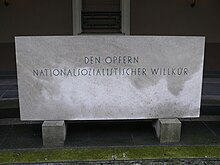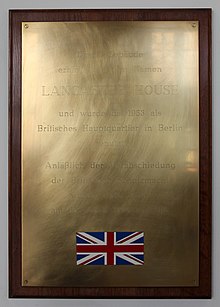Wilmersdorf town hall
| Wilmersdorf town hall | |
|---|---|
 Wilmersdorf town hall |
|
| Data | |
| place | Berlin-Wilmersdorf |
| architect | Helmut Remmelmann |
| Client | German labor front |
| Architectural style | Neoclassicism |
| Construction year | 1941-1943 |
| Coordinates | 52 ° 29 '22.9 " N , 13 ° 18' 48.5" E |
| particularities | |
| Was built as the administration building of the DAF | |
The former Wilmersdorf town hall in the Berlin district of Wilmersdorf ( Charlottenburg-Wilmersdorf district ) by Helmut Remmelmann was built between 1941 and 1943 as the last extension to the existing DAF administration building on Fehrbelliner Platz . The building stands on the property at Fehrbelliner Platz 4, Brienner Strasse 16, Mansfelder Strasse 8, Barstrasse and Hohenzollerndamm . It is a listed building monument. Its use as a town hall was given up at the end of 2014.
prehistory
As early as 1870 there were urban development plans by the urban developer Johann Anton Wilhelm von Carstenn , who wanted to build a country house settlement here, but which was not implemented due to Carstenn's bankruptcy. The development began around 1890 and expanded rapidly to almost the entire Wilmersdorf area. Instead of a country house settlement, five-story apartment buildings were built. Within a few years, Wilmersdorf grew from a small town with just under 5,000 inhabitants to a large city with over 100,000. This resulted in the need to build a town hall of its own.
First town hall Wilmersdorf

The Wilmersdorf town hall was built on the property at Brandenburgische Straße 2 and Gasteiner Straße in the years 1893 to 1894 according to plans and drafts by town building inspector August Lindemann at a price of 320,000 marks (adjusted for purchasing power in today's currency: around 2 million euros) on an area of 898 m². In keeping with the style of the time, the building was designed on the model of Italian town halls from the 14th and 15th centuries and clad with red facing. The community council had previously met in classrooms or private rooms. The building burned down in 1945. Plans for a large Wilmersdorf town hall on the Preußenpark that had existed since 1902 , for which three competitions were held, were never implemented, and the administration of Wilmersdorf continued to rely on the town hall, which had long been too small.
Second Wilmersdorf Town Hall
After the formation of Greater Berlin , the district office had used the Joachimsthal Gymnasium as a town house from 1920. After the town house was destroyed in 1943, large parts of the district administration moved into what is now the Goethe Gymnasium .
Third Wilmersdorf Town Hall
On the previously used as a sports field was built as the last building on Fehrbellinerplatz in the era of National Socialism , the headquarters of the German Labor Front as part of a unique administrative complex of the " Third Reich " consisting of the head office of Rudolph Karstadt AG, the management of Wiemer & Seek AG , the NS-Volkswohlfahrt , Gauamtsleitung Berlin (today: Landesversorgungsamt ), the Nordstern -Lebensversicherungsbank AG, the Reichsgetreidestelle and the insurance ring of the German Labor Front (today: Deutsche Rentenversicherung ). The area around Fehrbelliner Platz and the adjoining Preußenpark had been designated as the administrative center as early as the 1920s. The design of the semicircular shape of Fehrbelliner Platz, which opens onto the Preußenpark, is based on a design by Otto Firle .
architecture
Since concrete and steel were already allocated at the time the building was built, it was traditionally designed as masonry with a plastered facade. It is the only building of its kind on Fehrbelliner Platz. The architect, Helmut Remmelmann, worked in the design department at DAF. The curved front of the building completes the semicircular development on Hohenzollerndamm. The main entrance initially leads into the round courtyard flanked by columns in classical forms. The floor plan of the building resembles a keyhole with the round courtyard as the head and a larger farm yard. To achieve a representative impression, the ground floor was designed with horizontal, dark-colored plaster strips as a base. Parts of the architecture, especially the courtyard, are based on the police headquarters built in Copenhagen from 1919 to 1924 by the Danish architect Hack Kampmann . Since it was originally planned for a different purpose, it is one of the few town halls in Berlin, such as the Wedding Town Hall or the Marzahn Town Hall, without a town hall tower.
Below the farm yard there is an underground bunker with 1809 shelter places, which was probably created during the construction of the building. The facility was repaired and handed over to the Wilmersdorf District Office on July 20, 1981 as the seventh public civil protection room.
Additions from 1954
The original four-storey building was expanded by a fifth storey on the three side wings in 1958/1959. In 1957, 27 coat of arms mosaics designed by Ludwig Peter Kowalski of former East German states and cities were installed in the round courtyard, for which purpose the District Assembly (BVV) had explanatory boards attached in 1992, on which it is stated: “No claims are attached to these coats of arms. They are reminiscent of part of German and European history. "
In 1960 two memorial stones were erected: "The victims of National Socialist arbitrariness" and "The victims of the two world wars"; In 1981 a third memorial stone was added: "To the victims of communist arbitrariness". The Venetian fountain in the round courtyard was erected on September 2, 1988, the bronze bear by Hildebert Kliem on September 14, 1988. At the end of 2004, the sculpture "Reconciliation" returned to the round courtyard, where it had stood from 1979 to 1983.
A British telephone booth was put into operation in front of the town hall on March 5, 1987 , and a British post box is installed next to the entrance - both gifts from the former British protecting power.
In the entrance hall and in the former district council meeting room (3rd floor), the coats of arms of the Wilmersdorf twin cities are attached. In the vestibule of the BVV hall there are portraits of a number of Wilmersdorf mayors and district mayors and the text “From the community assembly to the district assembly”.
use
After completion, the DAF headquarters did not move into the building as planned. Instead, it was used by a Wehrmacht administration office of the Army High Command until the end of the war . From 1945 to 1953 it was the headquarters of the British occupying forces as "Lancaster House" . On April 1, 1954, the building was assigned to the Wilmersdorf district as the town hall. From 1954 the building was used as Wilmersdorf town hall. Because of the high real estate costs, the district office decided in January 2012 to give up the Wilmersdorf town hall as the district's administrative building. On March 8, 2012, BVV confirmed the decision. In April 2013, BVV moved to the Charlottenburg town hall . The administrative areas followed until the end of 2014.
A small market is held in front of the town hall on Tuesdays and Thursdays . The citizens' office and the municipal gallery will remain in the neighboring building at Hohenzollerndamm 177 even after the town hall has closed.
From August 14, 2015 to November 30, 2017, the former town hall served as an emergency shelter for refugees. The accommodation accommodated up to 1150 refugees and was one of the largest in Berlin. In August 2015, Federal President Joachim Gauck visited the emergency shelter.
The state audit office and the state labor court were discussed as subsequent users of the building . Finally, it was to serve as an alternative quarter for employees of the construction administration during the renovation of the high-rise in Württembergische Strasse.
literature
- Matthias Donath : Architecture in Berlin 1933–1945 . A city guide. Lukas Verlag, Berlin 2006, ISBN 978-3-936872-26-2 , pp. 255 ( Headquarters of the German Labor Front in the Google book search [accessed on December 9, 2014]).
- Hans-Jürgen Mende, Kurt Wernicke (Hrsg.): Berliner Bezirkslexikon Charlottenburg-Wilmersdorf . Haude & Spener, Berlin 2005, ISBN 3-7759-0479-4 (Edition Luisenstadt).
Web links
- From the community assembly to the district assembly. Brief history of the Wilmersdorf administration. District Office Charlottenburg-Wilmersdorf, accessed on December 29, 2014 .
- Wilmersdorf town hall. In: Bezirkslexikon. District Office Charlottenburg-Wilmersdorf, accessed on December 29, 2014 .
- Wilmersdorf Town Hall (I – III) in the district lexicon on luise-berlin.de
Individual evidence
- ↑ LDL-Berlin: Wilmersdorf Town Hall
- ↑ Frank Bachner, Cay Dobberke: The small BER from Wilmersdorf. Berlin: City Hall parade in City West. In: Der Tagesspiegel . June 10, 2014, accessed December 29, 2014 .
- ↑ Berlin, underground bunker Fehrbelliner Platz 4 on geschichtsspuren.de
- ↑ Coat of arms in the round courtyard of the Wilmersdorf town hall - explanatory board. District Office Charlottenburg-Wilmersdorf, accessed on December 29, 2014 .
- ↑ Headquarters at Fehrbelliner Platz, State Monument Office
- ↑ "Lancaster House" memorial plaque. In: List of honors of the Luisenstädtischer Bildungsverein .
- ↑ Location: Citizens' Registration Office Hohenzollerndamm. District Office Charlottenburg-Wilmersdorf, accessed on December 29, 2014 .
- ↑ Municipal Gallery Berlin. District Office Charlottenburg-Wilmersdorf, accessed on December 29, 2014 .
- ↑ Cay Dobberke: Wilmersdorf Town Hall is no longer an emergency shelter in: Der Tagesspiegel from November 30, 2017.
- ^ Farewell to Wilmersdorf Town Hall at the end of the year. ( Memento of the original from January 4, 2015 in the Internet Archive ) Info: The archive link was automatically inserted and not yet checked. Please check the original and archive link according to the instructions and then remove this notice. In: Berliner Woche , November 24, 2014
- ↑ Cay Dobberke: Emergency accommodation in Wilmersdorf town hall will close soon. In: Der Tagesspiegel from October 7, 2017







